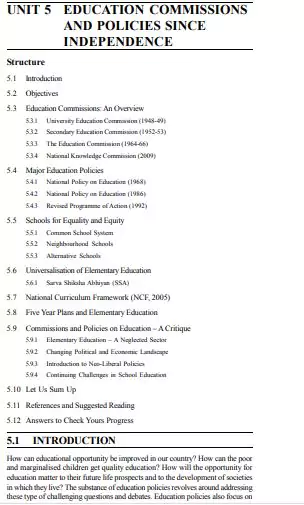‘List Of Committees and Commissions on Education in India’ PDF Quick download link is given at the bottom of this article. You can see the PDF demo, size of the PDF, page numbers, and direct download Free PDF of ‘Committees and Commissions on Education in India’ using the download button.
Committees and Commissions on Education in India List PDF Free Download

Committees and Commissions on Education in India
How can the educational opportunities be improved in our country? How can poor and marginalized children get quality education?
How will the opportunity for education matter to their future life prospects and to the development of the societies in which they live?
The substance of education policies revolves around addressing these types of challenging questions and debates.
Education policies also focus on options to effect systemic change in education systems.
This Unit is a discussion on Education Commissions and Policies on education independent India.
The Unit examines the debates on education and enables us to understand the States’ role in education, State education policy, and the current challenges in State policy.
It is an attempt to understand the major initiatives undertaken to achieve the goals of equity, equality, and quality in education and analyze the constraints in the achievement of these goals.
Education Commissions: An Overview
The educational situation on the eve of independence was quite bleak. In spite of all that had been achieved under British Rule, we began our freedom with a fairly low level of attainment in education in almost all respects.
There were 17universities and 636 colleges (with a total enrolment of 2,38,000 students), 5,297secondary schools with 8,70,000 pupils (which implied that not even one youth in every twenty in the age-group 14-17 was in school), 12,843 middle schools with two million pupils (which meant that only one child out of every eleven in the age-group 11-14 was enrolled) and 1,72,661 primary schools with fourteen million pupils (which implied that only one child out of every three in the age-group 6- 11 was in school).
Vocational and technical education was poorly developed, both at the school and university stages, and the supply of high-level trained scientific manpower was very limited.
Educational inequalities were very large, especially between one region and another, between urban and rural areas, between men and women, and between the advanced and intermediate castes on the one hand and the scheduled castes and tribes on the other.
The standards of education are generally unsatisfactory, especially at the school stage, with too much emphasis on English and too little stress on Mathematics, Science, or the Indian languages.
The percentage of literacy was only about fourteen and the total educational expenditure was just about Rs. 570 million or less than half a percent of the national income.
It was this challenging situation that the nation was called upon to reform when it kept its first tryst with destiny in 1947 (Naik, 1947).
Against the above background, in the aftermath of Independence, several Committees and Commissions were constituted to analyze the problems and suggest a way forward.
It was felt that Universities could play a significant role in the development process.
It was suggested that the duties and responsibilities of the Universities were significant and needed in the light of the leadership they were expected to provide in politics, administration, the professions, industry, and commerce.
They were expected to enable the country to free itself from want, disease, and ignorance by developing scientific and technical knowledge.
So the first Commission formed was the Commission on University Education. 5.3.1 University Education Commission (1948-49) The University Education Commission (1948-49) was the first Commission on Education after Independence.
Its major emphasis was on higher education but it also touched upon the issues related to school education.
The Commission was appointed under the chairmanship of Dr. S. Radhakrishan, a great visionary of the modern era.
The Radhakrishnan Commission on University Education defined the vital tasks of higher education.
The aim of the university should be to produce able citizens who can take up national responsibilities successfully in various fields.
The university has to produce able administrators and suitable workers in various occupations and industries. It has to provide leadership in various walks of life in the best interest of the nation.
The Commission recommended that the standard of admission to University courses should correspond to that of the present intermediate examination, i.e., after 12 years of study at school and intermediate college.
It remarked that “our secondary education remains the weakest link in our educational machinery and needs urgent reforms.”
The Commission stated that the function of school education is to provide good general education, it further spelled out the elements of good education “which will not only prepare a pupil for university work but at the same time prepare him for practical work to earn his living if he did not proceed to a university.
The Commission suggested that the functions of a school and a university should be different.
The function of a school should be to provide suitable education to those who join higher education and also to those who do not have the intention of proceeding further.
Education of both sets could be combined together, whereas some schools could train students for work in the agriculture industry and commerce.
The University Education Commission laid great stress on the introduction of general education throughout the school.
The Commission clearly wanted schools should diversify their outcomes in such a way that many could effectively participate in real life by taking up jobs or self-employment and only very few would continue to study beyond school.
5.3.2 Secondary Education Commission (1952-53) The concerns of education articulated during the freedom struggle were revisited by the National Commissions – the Secondary Education Commission (1952- 53), and the Education Commission (1964-66).
Both Commissions elaborated on the themes emerging out of Mahatma Gandhi’s educational philosophy in the changed socio-political context with a focus on national developments (NCF, 2005, p.3).
A separate education commission was appointed under the chairmanship of Dr. Lakshamanaswami Mudaliyar in 1952 to address the issues related to school education.
The Commission Report (1952) had envisaged schools to play a crucial role in developing democratic citizenship, emphasizing that “democracy is based on faith and in the dignity and worth of every single “individual”, where the innate worth fullness cannot be eclipsed either by economic or racial or social consideration (SEC, 1952, p.20).”
| Author | – |
| Language | English |
| No. of Pages | 24 |
| PDF Size | 1.3 MB |
| Category | Education |
| Source/Credits | egyankosh.ac.in |
Related PDFs
Notary Interview 2023 Maharashtra PDF
Budget Making Process In India PDF
Types And Phases of Evaluation In Education PDF
Study Abroad in the United States: A Guide for International Students PDF
Unit6 Attitude Measurement And Scale PDF
Committees and Commissions on Education PDF Free Download
